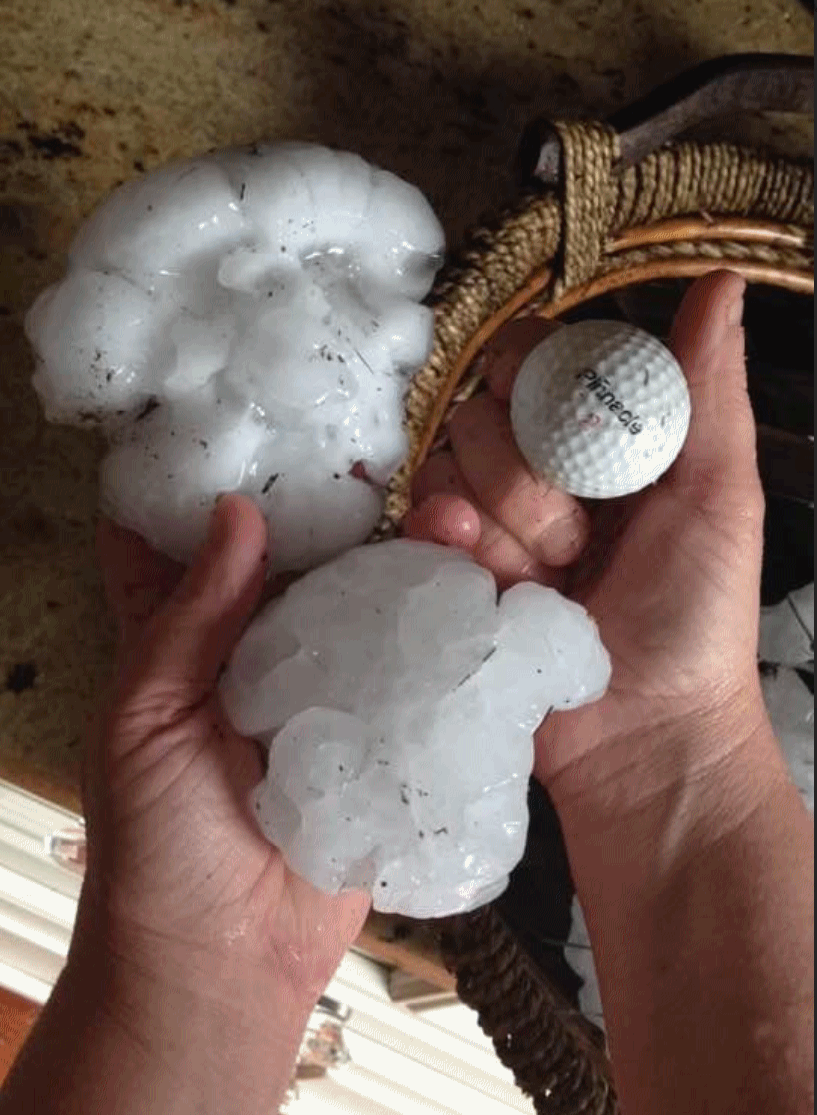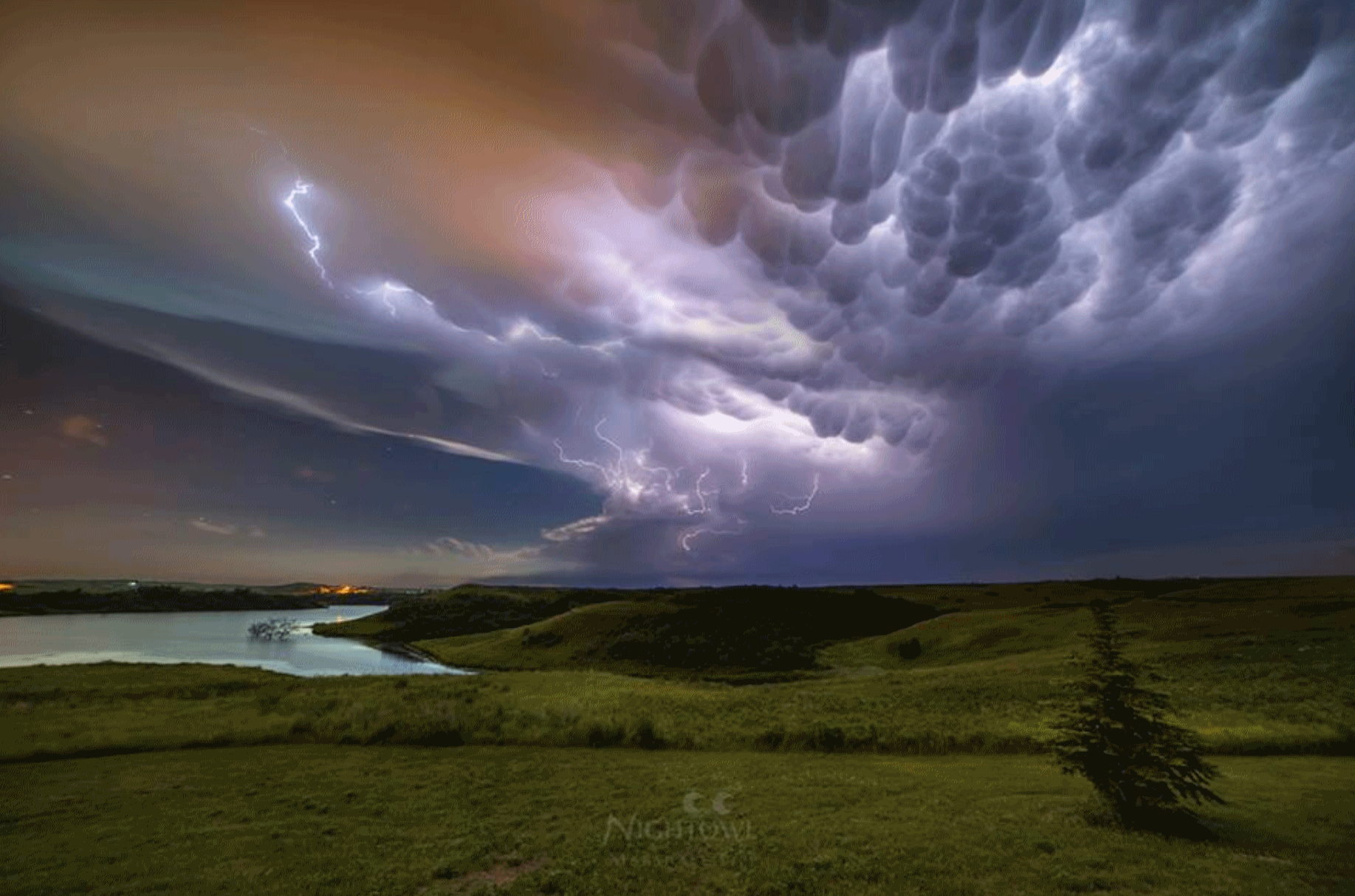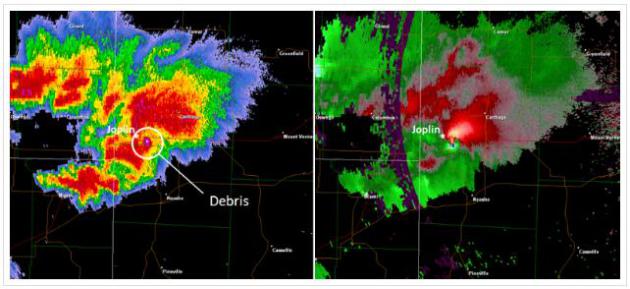83 F. high temperature at KMSP Wednesday.
81 F. average high on June 22.
82 F. high on June 22, 2015.
June 23, 2002:
Just a few weeks after torrential rains hit the area, another round of
heavy rain hits northern Minnesota. This time up to eight inches would
fall in a two-day period in parts of Mahnomen and St. Louis Counties.
Camping Up North? Take a NOAA Weather RadioThe death of Minnesota Rep. Tim Walz's brother during
Sunday's
severe storm in the BWCA was a painful reminder of the risks posed by
high winds - with no suitable shelter nearby. Every summer the question
surfaces: where should I go when thunderstorms rumble above my tent or
camper?
A new generation of smartphone apps can deliver
GPS-specific warnings, but cell phone coverage in the BWCA is spotty.
Your best bet? Take along a
portable NOAA Weather Radio,
which should work almost everywhere. It may be impossible to avoid
falling trees, but finding a cave, a clearing or even an outcropping of
rocks provides some protection.
Someone should hurry up and invent an indestructible sleeping bag.
No drama today, just a transfusion of cooler air as high pressure passes overhead. Lake-worthy 80s return
Friday with enough low-level moisture to fuel a few strong to severe T-storms
Saturday. Enjoy a shot at 90F
Saturday, because next week looks cooler and drier.
The heat wave gripping the southwest USA shows no sign of invading Minnesota anytime soon.
4th of July highs here may reach the 80s.
NOAA Weather Radio Coverage in Minnesota.
Coverage is good, statewide, with the exception of a gap north of
Bemidji. It's not perfect, but if you're camping in northern Minnesota,
especially the Arrowhead or BWCA you stand a better chance of getting
that severe storm warning via NOAA Weather Radio then relying on a cell
signal. For more details from
NOAA click here.
Next Severe Risk: Saturday.
Today will be comfortable with 70s and lower dew points. Winds swing
around to the southeast Friday, luring the mercury back into the
mid-80s. By Saturday, with dew points in the low 70s, significant
instabiity and wind shear overhead conditions may be ripe for a few
strong to severe T-storms across much of Minnesota and western
Wisconsin, according to NOAA SPC.
Saturday Heat Index: Low to Mid 90s.
Although surface temperatures will be in the upper 80s to near 90F a
high dew point will make all the difference - by late afternoon you may
be hoping for a cooling shower, without beachball-size hail and
tree-tangling winds. Heat Index forecast: Aeris Enterprise.
Heaviest Rains Track South of Minnesota.
Here is the 10-day accumulated rainfall product from NOAA's GFS model,
showing the heaviest rains from near Omaha to Chicago and the eastern
seaboard. We'll see some rain Saturday, but right now it looks like much
of next week will be dry. Source: AerisWeather.
Hot 4th of July?
Not buying it just yet with conflicting model runs, but GFS guidance is
suggesting low 90s on Monday, the 4th. Considering Minnesota's hottest
weather usually comes 2-3 weeks after the solstice it isn't much of a
stretch.
While Western USA Continues to Sizzle.
The mean ridge axis is setting up over the western third of the USA,
implying more record heat (and wildfires) for much of the west into at
least mid-July. A light northwest flow at 500 mb may take some of the
edge off the heat for the Upper Midwest and Great Lakes.
The Southwest Burns as Record Heat Sparks Volatile Wildfires. Here's an except of a good summary at
Mashable: "...
A
heat dome comprised of an intense, sprawling area of high pressure sat
on top of the Southwest for a third straight day. Although it shows some
signs of weakening, the heat dome may intensify again by early next
week, raising the possibility of a prolonged hot and dry weather pattern
in an already parched region.
Firefighters are making some headway in containing fires across the
Southwest, though exceedingly hot temperatures in the region aren't
helping..."
Photo credit: "
Smoke from wildfires burning in Angeles National Forest fills the sky behind the Los Angeles skyline on Monday, June 20, 2016." Image: Ringo H.W. Chiu/AP.
 Kansas-Size Hailstones
Kansas-Size Hailstones.
Thanks to Jim and Jorie Lindner, who live on Little Pelican Lake, about
5 miles south of Breezy Point, for sending in what appears to be
hailstones larger than baseball-size. That stone under the basket
appears to be grapefruit size, something you'd expect to see near
Wichita or Tulsa, not the North Woods of Minnesota.
Joplin Tornado Sparks Research Among Engineers, Meteorologists, Social Scientists. Here's an excerpt from
The Joplin Globe: "...
Marc
Levitan, lead author of the study and the acting director of NIST, said
the agency’s next focus is replacing the Enhanced Fujita (EF) scale
used to rate tornado strength. The EF rating is based on expert
guesswork. After a storm, top meteorologists and structural engineers
are sent photos of the damage, which they use to estimate wind speed.
According to Levitan, a more precise method is needed to measure the
strength of storms so that buildings can be constructed to weather the
conditions they will actually face. “The EF scale is based on expert
judgment,” he said. “We’re trying to do the analysis so we can replace
the EF scale with engineering-based standards...” (Image credit: NOAA).
In 100 Years, $77 Billion Worth of San Francisco Property Could Be Underwater.
Co.Exist has the story; here's a snippet: "...
If
you set plans for how you're going to build buildings and sea walls and
protect infrastructure—and you invest billions over decades, and then
it turns out that your estimates of sea level rise were too low—then the
implications for cost are very significant." Not to mention the people
living there. Around the city, more than 200,000 commercial and
residential buildings—along with major infrastructure like the
airport—are at risk from either temporary flooding or permanent loss due
to sea level rise if the city does nothing to prepare. Even more
dangerously, the risk extends well inland, and isn't limited to property
directly on the coast..."
As Sea Levels Rise, Rotterdam Floats To The Top As An Exammple of How To Live With Water. Here's a clip from an interesting story at PRI,
Public Radio International: "...
All
these innovations and more have made the Netherlands a mecca for people
from other parts of the world that are confronting a future of rising
seas. Delegations from abroad are constantly scouring the country for
ideas, and the Dutch are more than eager to share their expertise — in
no small part because Dutch engineers and consultants specializing in
climate change adaptation and water management stand to benefit from
international business partnerships. But that doesn’t mean they’re
complacent. “We keep on learning and adapting,” says
Carola van Gelder, a senior advisor for the national water management
authority and a lead on the Zandmotor project. “It’s not that we know it
all, definitely not … That’s why we go abroad and look at other ways of
dealing with climate change..."
Photo credit: "
IJburg, a neighborhood of floating houses on the eastern edge of Amsterdam.
" Credit: Joris van Gennip/The GroundTruth Project.
Another Age of Discovery. Thomas Friedman at
The New York Times
makes the case that radical shifts in technology and innovation,
disruption on a massive scale, can leave many people unsettled, their
skills no longer in demand - which has political implications; here's an
excerpt: "...
Because, as in the Renaissance, key anchors in
people’s lives — like the workplace and community — are being
fundamentally dislocated. The pace of technological change is
outstripping the average person’s ability to adapt. Now, like then, said
Goldin, “sizable parts of the population found their skills were no
longer needed, or they lived in places left behind, so inequality grew.”
At the same time, “new planetary scale systems of commerce and
information exchange led to immense improvements in choices and
accelerating innovations which made some people fabulously rich...”
A Place at the Table.
This documentary was launched in 2012, but the problem remains as
relevant and critical as ever. "The future belongs to those who believe
in the beauty of their dreams", said Eleanor Roosevelt. Those dreams can
become daunting when you're hungry on a daily basis. An estimated 50
million Americans, including 1 in 4 kids, suffer from food insecurity.
Much of America is a "food desert", with no easy availability of healthy
fruits and vegetables. We're being incentivized, through generous
government subsidies to agribusiness, to eat the wrong foods, and then
wonder out loud why we have an obesity epidemic and more people than
ever diagnosed with Type 2 diabetes. Watch
this Netflix documentary, and then remind your state and national representatives that the richest country on Earth can do better: "
A Place at the Table shows
us how hunger poses serious economic, social and cultural implications
for our nation, and that it could be solved once and for all, if the
American public decides — as they have in the past — that making healthy
food available and affordable is in the best interest of us all."
Can Netflix Survive In The New World It Created? Here's an excerpt of an interesting story at
The New York Times Magazine: "...
Just
because Netflix had essentially created this new world of internet TV
was no guarantee that it could continue to dominate it. Hulu, a
streaming service jointly owned by 21st Century Fox, Disney and NBC
Universal, had become more assertive in licensing and developing shows,
vying with Netflix for deals. And there was other competition as well:
small companies like Vimeo and giants like Amazon, an aggressive buyer
of original series. Even the networks, which long considered Netflix an
ally, had begun to fight back by developing their own streaming apps..."
Illustration credit:
Erik Carter.
 TODAY
TODAY: Partly sunny, pleasant. Winds: NE 7-12. High: 76
THURSDAY NIGHT: Mostly clear, more comfortable. Low: 62
FRIDAY: Sunny, warm enough for the lake. Winds: SE 10-15. High: 85
SATURDAY: Some sticky sun. Few severe storms? Winds: S 10-20. Wake-up: 70. High: near 90
SUNDAY: Plenty of sun, turning less humid. Winds: W 10-20. Wake-up: 64. High: 85
MONDAY: Intervals of sun, almost comfortable. Winds: NW 10-15. Wake-up: 62. High: 77
TUESDAY: Mix of clouds & sun, no weather drama. Winds: N 5-10. Wake-up: 58. High: 76
WEDNESDAY: Sunny and pleasant. Winds: E 5-10. Wake-up: 57. High: near 80
Photo credit of illuminated mammatus clouds over North Dakota:
Marshall Lipp.
Climate Stories...
 A Peek Into the Relatively Sane Climate Debates Outside the United States. Grist
A Peek Into the Relatively Sane Climate Debates Outside the United States. Grist
takes a look at how conservative parties in just about every other
country on Earth have accepted the science and are now focusing on
solutions: "...
Norwegian researcher Sondre Båtstrand last year compared conservative parties in
the United Kingdom, Norway, Sweden, Spain, Canada, New Zealand,
Germany, and Australia, finding that the U.S. Republican Party alone was
“an anomaly in denying anthropogenic climate change.” Even when
conservative candidates argue against climate-change action in their
home countries, scientific denial is rarely part of the conversation.
Here’s a whirlwind tour of the climate and energy debate around the
world (which is thoroughly blissful compared to U.S. politics).." (Image credit: NASA).
 Nuclear New-Build Not Fast Enough to Curb Global Warming: Report. Reuters
Nuclear New-Build Not Fast Enough to Curb Global Warming: Report. Reuters has the story; here's the intro: "
Nuclear
reactors are not being built rapidly enough around the world to meet
targets on curbing global warming, a report by the World Nuclear
Association, an industry body, said on Tuesday.
The association, which represents the global nuclear industry, says
1,000 gigawatts of new nuclear capacity needs to be added by 2050 so
nuclear can supply around 25 percent of global electricity.
Last year, more nuclear reactors were under construction and came
online than at any other time in the past 25 years and building times
have improved..."
Photo credit above: "Two
cooling towers and pressurized water reactors of the nuclear power
plant of French supplier Electricite de France (EDF) are pictured in
Cattenom, eastern France, January 27, 2016." Reuters/Wolfgang Rattay.
People Don't Trust Hypocritical Climate Scientists, Study Finds. Here's an excerpt of a story at
Grist: "...
According
to the research, people are more forgiving of a climate scientist who
flies often than one who lives in an enormous mansion. “If I live in a
huge, gargantuan house … my credibility completely plummets,” Attari
says. She suspects this is because people are more likely to understand
that climate researchers are required to fly for work, while they have
more choice over what they do at home. Some climate researchers have
started to limit their flights, but it’s really hard, Attari says..."
Minnesota Second-Most Affected State in U.S. for Climate Change. Here's an excerpt of an article that appeared at
The Grand Forks Herald: "...
Seeley
presented this data, collected in collaboration with the National
Oceanic and Atmospheric Administration, which showed significant climate
changes in Minnesota in terms of increases in average temperatures,
moisture and severe storms. In fact, he said Minnesota had the most
significant changes in the country next to Alaska. "You happen to live
here in northwestern Minnesota, where we're seeing your minimum winter
temperatures rise at a pace of change that equates to five degrees per
century - which is a pretty steep change," said Seeley, who says the
average winter low increase in Minnesota is around 2 percent..."
Photo credit: "
Climatologist
Mark Seeley, shows the crowd attending the Climate Minnesota event
Monday how winter minimum temperatures have been increasing over the
past century. The event drew in advocates for action on the issue of
climate change." DETROIT LAKES TRIBUNE/Paula Quam.
 Scorching Hot Southwest is Climate Change in Action.
Much of the USA is baking, and warmer background temperatures may be
amplifying and magnifying the heat. Here's an excerpt from Huffington Post: "...Michael
Mann, a leading climate scientist and professor of meteorology at Penn
State University, was in Phoenix on Friday when temperatures hit 106
degrees. He was speaking at a Democratic National Platform committee
meeting, where he pointed to the extreme weather as “an example of just
the sort of extreme heat that is on the increase due to human-caused
climate change,” he told HuffPost. “The likelihood of record heat has
already doubled in the U.S. due to human-caused warming,” he said, “and
that’s just the tip of the proverbial iceberg.” Daily records were also
set in California, where Burbank reached 109 degrees and Palm Springs soared to 119
Scorching Hot Southwest is Climate Change in Action.
Much of the USA is baking, and warmer background temperatures may be
amplifying and magnifying the heat. Here's an excerpt from Huffington Post: "...Michael
Mann, a leading climate scientist and professor of meteorology at Penn
State University, was in Phoenix on Friday when temperatures hit 106
degrees. He was speaking at a Democratic National Platform committee
meeting, where he pointed to the extreme weather as “an example of just
the sort of extreme heat that is on the increase due to human-caused
climate change,” he told HuffPost. “The likelihood of record heat has
already doubled in the U.S. due to human-caused warming,” he said, “and
that’s just the tip of the proverbial iceberg.” Daily records were also
set in California, where Burbank reached 109 degrees and Palm Springs soared to 119..."
Photo credit: AP. "
A home builder works at sunrise on Monday in Gilbert, Arizona, in an effort to beat the rising temperatures."
Loading Dice In Favor of More Intense Heat Events. The warm signal is already showing up, helping to make heat waves deeper and longer. Graphic credit:
WXshift.
Seven Climate Records Set So Far in 2016. Here's an excerpt from
The Guardian: "
Every month this year has been the hottest on record globally for that month. May, data published this week by NASA revealed, was no exception. Nasa’s dataset, one of three main global surface temperature records, shows February recorded the highest anomaly against long term average temperatures...."
The Mistrust of Science. The New Yorker has an illuminating story; here's an excerpt: "...
The
scientific orientation has proved immensely powerful. It has allowed us
to nearly double our lifespan during the past century, to increase our
global abundance, and to deepen our understanding of the nature of the
universe. Yet scientific knowledge is not necessarily trusted. Partly,
that’s because it is incomplete. But even where the knowledge provided
by science is overwhelming, people often resist it—sometimes outright
deny it. Many people continue to believe, for instance, despite massive
evidence to the contrary, that childhood vaccines cause autism (they do
not); that people are safer owning a gun (they are not); that
genetically modified crops are harmful (on balance, they have been
beneficial); that climate change is not happening (it is)..."






No comments:
Post a Comment